THASOS Thrace 148BC Authentic Ancient Silver Greek Tetradrachm Coin NGC i72601
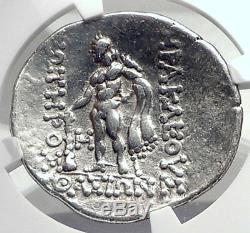
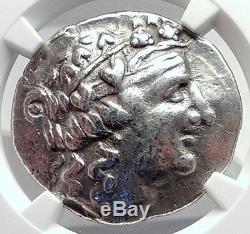
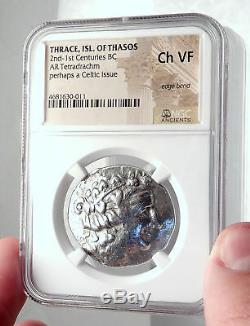
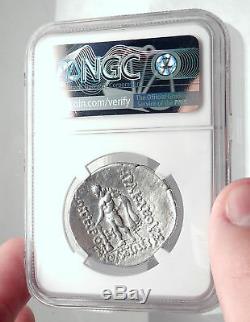
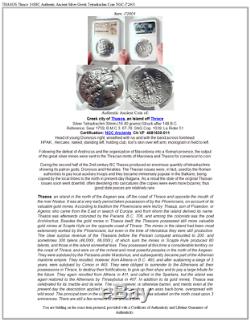


Item: i72601 Authentic Ancient Coin of. Silver Tetradrachm 30mm (16.40 grams) Struck after 148 B. 1039; Le Rider 51 Certification: NGC Ancients.
Ch VF 4681630-011 Head of young Dionysos right, wreathed with ivy and with the band across forehead. HPAK , Hercules, naked, standing left, holding club, lion's skin over left arm; monogram in field to left. Following the defeat of Andriscus and the organization of Macedonia into a Roman province, the output of the great silver mines were sent to the Thracian mints of Maroneia and Thasos for conversion to coin. During the second half of the 2nd century BC Thasos produced an enormous quantity of tetradrachms showing its patron gods, Dionysos and Herakles. The Thasian issues were, in fact, used by the Roman authorities to pay local auxiliary troops and they became immensely popular in the Balkans, being copied by the local tribes to the north in present-day Bulgaria.
As a result the style of the original Thasian issues soon went downhill, often devolving into caricatures (the copies were even more bizarre); thus good style pieces are relatively rare. Thasos , an island in the north of the Aegean sea, off the coast of Thrace and opposite the mouth of the river Nestus. It was at a very early period taken possession of by the Phoenicians, on account of its valuable gold mines. According to tradition the Phoenicians were led by Thasus, son of Poseidon, or Agenor, who came from the East in search of Europa, and from whom the island derived its name. Thasos was afterwards colonized by the Parians, B.708, and among the colonists was the poet Archilochus. Besides the gold mines in Thasos itself, the Thasians possessed still more valuable gold mines at Scapte Hyle on the opposite coast of Thrace. The mines in the island had been most extensively worked by the Phoenicians, but even in the time of Herodotus they were still productive. The clear surplus revenue of the Thasians before the Persian conquest amounted to 200, and sometimes 300 talens 46,000l.
, of which sum the mines in Scapte Hyle produced 80 talents, and those in the island somewhat less. They possessed at this time a considerable territory on the coast of Thrace, and were on of the richest and most powerful peoples in the north of the Aegean. They were subdued by the Persians under Mardonius, and subsequently became part of the Athenian maritime empire. They revolted, however, from Athens in B.
465, and after sustaining a siege of 3 years, were subdued by Cimon in 463. They were obliged to surrender to the Athenians all their possessions in Thrace, to destroy their fortifications, to give up their ships and to pay a large tribute for the future. They again revolted from Athens in 411, and called in the Spartans, but the island was again restored to the Athenians by Thrasybulus in 407. In addition to its gold mines, Thasos was celebrated for its marble and its wine. The soil, however, is otherwise barren, and merits even at the present day the description applied to it by poet Archilochus, - an asss back-bone, overspread with wild wood. The principal town in the island, also called Thasos, was situated on the north coast upon 3 eminences.There are still a few remains of the ancient town. Dionysus is the god of the grape harvest, winemaking and wine, of ritual madness, fertility, theatre and religious ecstasy in Greek mythology. Alcohol, especially wine, played an important role in Greek culture with Dionysus being an important reason for this life style. His name, thought to be a theonym in Linear B tablets as di-wo-nu-so (KH Gq 5 inscription), shows that he may have been worshipped as early as c. His origins are uncertain, and his cults took many forms; some are described by ancient sources as Thracian, others as Greek.
In some cults, he arrives from the east, as an Asiatic foreigner; in others, from Ethiopia in the South. He is a god of epiphany, "the god that comes", and his "foreignness" as an arriving outsider-god may be inherent and essential to his cults. He is a major, popular figure of Greek mythology and religion, and is included in some lists of the twelve Olympians. Dionysus was the last god to be accepted into Mt.
He was the youngest and the only one to have a mortal mother. His festivals were the driving force behind the development of Greek theatre. Modern scholarship categorises him as a dying-and-rising god.
The earliest cult images of Dionysus show a mature male, bearded and robed. He holds a fennel staff, tipped with a pine-cone and known as a thyrsus. Later images show him as a beardless, sensuous, naked or half-naked androgynous youth: the literature describes him as womanly or "man-womanish".
In its fully developed form, his central cult imagery shows his triumphant, disorderly arrival or return, as if from some place beyond the borders of the known and civilized. His procession (thiasus) is made up of wild female followers (maenads) and bearded satyrs with erect penises.
Some are armed with the thyrsus , some dance or play music. The god himself is drawn in a chariot, usually by exotic beasts such as lions or tigers, and is sometimes attended by a bearded, drunken Silenus. This procession is presumed to be the cult model for the human followers of his Dionysian Mysteries.
In his Thracian mysteries, he wears the bassaris or fox-skin, symbolizing a new life. Dionysus is represented by city religions as the protector of those who do not belong to conventional society and thus symbolizes everything which is chaotic, dangerous and unexpected, everything which escapes human reason and which can only be attributed to the unforeseeable action of the gods. Also known as Bacchus , the name adopted by the Romans and the frenzy he induces, bakkheia. His thyrsus is sometimes wound with ivy and dripping with honey. It is a beneficent wand but also a weapon, and can be used to destroy those who oppose his cult and the freedoms he represents.
He is also called Eleutherios ("the liberator"), whose wine, music and ecstatic dance frees his followers from self-conscious fear and care, and subverts the oppressive restraints of the powerful. Those who partake of his mysteries are possessed and empowered by the god himself. His cult is also a "cult of the souls"; his maenads feed the dead through blood-offerings, and he acts as a divine communicant between the living and the dead. In Greek mythology, he is presented as a son of Zeus and the mortal Semele, thus semi-divine or heroic: and as son of Zeus and Persephone or Demeter, thus both fully divine, part-chthonic and possibly identical with Iacchus of the Eleusinian Mysteries. Some scholars believe that Dionysus is a syncretism of a local Greek nature deity and a more powerful god from Thrace or Phrygia such as Sabazios or Zalmoxis.
Heracles , born Alcaeus (Alkaios) or Alcides , was a divine hero in Greek mythology, the son of Zeus and Alcmene, foster son of Amphitryon and great-grandson and half-brother (as they are both sired by the god Zeus) of Perseus. He was the greatest of the Greek heroes, a paragon of masculinity, the ancestor of royal clans who claimed to be Heracleidae and a champion of the Olympian order against chthonic monsters. In Rome and the modern West, he is known as Hercules , with whom the later Roman emperors, in particular Commodus and Maximian, often identified themselves. The Romans adopted the Greek version of his life and works essentially unchanged, but added anecdotal detail of their own, some of it linking the hero with the geography of the Central Mediterranean.
Details of his cult were adapted to Rome as well. Extraordinary strength, courage, ingenuity, and sexual prowess with both males and females were among the characteristics commonly attributed to him. Heracles used his wits on several occasions when his strength did not suffice, such as when laboring for the king Augeas of Elis, wrestling the giant Antaeus, or tricking Atlas into taking the sky back onto his shoulders. Together with Hermes he was the patron and protector of gymnasia and palaestrae.His iconographic attributes are the lion skin and the club. These qualities did not prevent him from being regarded as a playful figure who used games to relax from his labors and played a great deal with children. By conquering dangerous archaic forces he is said to have "made the world safe for mankind" and to be its benefactor. Heracles was an extremely passionate and emotional individual, capable of doing both great deeds for his friends (such as wrestling with Thanatos on behalf of Prince Admetus, who had regaled Heracles with his hospitality, or restoring his friend Tyndareus to the throne of Sparta after he was overthrown) and being a terrible enemy who would wreak horrible vengeance on those who crossed him, as Augeas, Neleus and Laomedon all found out to their cost.
Thasos or Thassos (Greek:) is a Greek island, geographically part of the North Aegean Sea, but administratively part of the Kavala regional unit. It is the northernmost Greek island, and 12th largest by area.
Thasos is also the name of the largest town of the island (officially known as Limenas Thasou , "Port of Thasos"), situated at the northern side, opposite the mainland and about 10 kilometres (6 miles) from Keramoti. Thassos island is known from ancient times for its termae making it a climatic and balneoclimateric resort area. Thasos' economy relies on timber (it is rich in forests), marble quarries, olive oil and honey. Tourism has also become important since the 1960s, although not to the level of other Greek islands. The island was colonised at an early date by Phoenicians, attracted probably by its gold mines; they founded a temple to the god Melqart, whom the Greeks identified as "Tyrian Heracles", and whose cult was merged with Heracles in the course of the island's Hellenization.The temple still existed in the time of Herodotus. An eponymous Thasos or Thasus, son of Phoenix (or of Agenor, as Pausanias reported) was said to have been the leader of the Phoenicians, and to have given his name to the island. Around 650 BC, or a little earlier, Greeks from Paros founded a colony on Thasos. A generation or so later, the poet Archilochus, a descendant of these colonists, wrote of casting away his shield during a minor war against an indigenous Thracian tribe, the Saians.
Thasian power, and sources of its wealth, extended to the mainland, where the Thasians owned gold mines even more valuable than those of the island; their combined annual revenues amounted to between 200 and 300 talents. Herodotus says that the best mines on the island were those opened by the Phoenicians on the east side of the island, facing Samothrace. Archilochus described Thasos as an ass's backbone crowned with wild wood. The island's capital, Thasos, had two harbours.
Besides its gold mines, the wine, nuts and marble of Thasos were well known in antiquity. Thasian wine was quite famous. Thasian coins had the head of the wine god Dionysos on one side and bunches of grape of the other. Thasos was important during the Ionian Revolt against Persia. After the capture of Miletus (494 BC) Histiaeus, the Ionian leader, laid siege.
The attack failed, but, warned by the danger, the Thasians employed their revenues to build war ships and strengthen their fortifications. This excited the suspicions of the Persians, and Darius compelled them to surrender their ships and pull down their walls.
After the defeat of Xerxes the Thasians joined the Delian League; but afterwards, on account of a difference about the mines and marts on the mainland, they revolted. The Athenianss defeated them by sea, and, after a siege that lasted more than two years, took the capital, Thasos, probably in 463 BC, and compelled the Thasians to destroy their walls, surrender their ships, pay an indemnity and an annual contribution (in 449 BC this was 21 talents, from 445 BC about 30 talents), and resign their possessions on the mainland. In 411 BC, at the time of the oligarchical revolution at Athens, Thasos again revolted from Athens and received a Lacedaemonian governor; but in 407 BC the partisans of Lacedaemon were expelled, and the Athenians under Thrasybulus were admitted. After the Battle of Aegospotami (405 BC), Thasos again fell into the hands of the Lacedaemonians under Lysander who formed a decarchy there; but the Athenians must have recovered it, for it formed one of the subjects of dispute between them and Philip II of Macedonia.In the embroilment between Philip V of Macedonia and the Romans, Thasos submitted to Philip, but received its freedom at the hands of the Romans after the Battle of Cynoscephalae (197 BC), and it was still a "free" state in the time of Pliny. Thasos was part of the Eastern Roman Empire, now known as the Byzantine Empire, from 395 on. According to the 6th century Synecdemus , it belonged to the province of Macedonia Prima, although the 10th century De thematibus claims that it was part of Thracia. The island was a major source of marble until the disruption of the Slavic invasions in the late 6th/7th centuries, and several churches from Late Antiquity have been found on it. The island remained in Byzantine hands for most of the Middle Ages.
It functioned as a naval base in the 13th century, under its own doux , and came briefly under the rule of the Genoese Tedisio Zaccaria in 1307-13. Returning to Byzantine control, its bishopric was raised to an archdiocese by Manuel II Palaiologos. Thasos was captured by the Genoese Gattilusi family ca. 1434, who surrendered it to the Ottoman Empire in 1455. Following the Ottoman conquest of the Despotate of the Morea in 1460, the former Despot Demetrios Palaiologos received lands on the island. It is related that the Byzantine Greek Saint Joannicius the Great (752-846) in one of his miracles freed the island of Thasos from a multitude of snakes. World-renowned expert numismatist, enthusiast, author and dealer in authentic ancient Greek, ancient Roman, ancient Byzantine, world coins & more. Ilya Zlobin is an independent individual who has a passion for coin collecting, research and understanding the importance of the historical context and significance all coins and objects represent. Send me a message about this and I can update your invoice should you want this method.Getting your order to you, quickly and securely is a top priority and is taken seriously here. Great care is taken in packaging and mailing every item securely and quickly.
What is a certificate of authenticity and what guarantees do you give that the item is authentic? You will be very happy with what you get with the COA; a professional presentation of the coin, with all of the relevant information and a picture of the coin you saw in the listing. Additionally, the coin is inside it's own protective coin flip (holder), with a 2x2 inch description of the coin matching the individual number on the COA. Whether your goal is to collect or give the item as a gift, coins presented like this could be more prized and valued higher than items that were not given such care and attention to.
When should I leave feedback? Please don't leave any negative feedbacks, as it happens sometimes that people rush to leave feedback before letting sufficient time for their order to arrive.
The matter of fact is that any issues can be resolved, as reputation is most important to me. My goal is to provide superior products and quality of service. How and where do I learn more about collecting ancient coins? Visit the Guide on How to Use My Store. For on an overview about using my store, with additional information and links to all other parts of my store which may include educational information on topics you are looking for.The item "THASOS Thrace 148BC Authentic Ancient Silver Greek Tetradrachm Coin NGC i72601" is in sale since Thursday, October 4, 2018. This item is in the category "Coins & Paper Money\Coins\ Ancient\Greek (450 BC-100 AD)". The seller is "highrating_lowprice" and is located in Rego Park, New York.
This item can be shipped worldwide.- Composition: Silver
- Denomination: Tetradrachm
- Culture: Greek
- Material: Silver
- Certification Number: 4681630-011
- Grade: VF
- Certification: NGC


